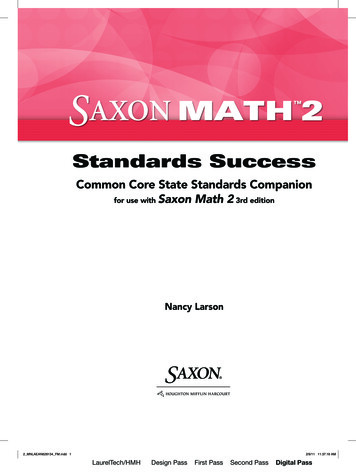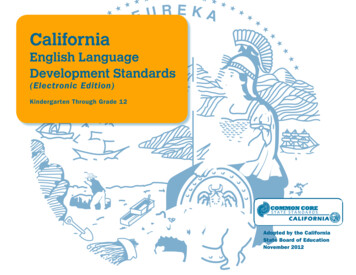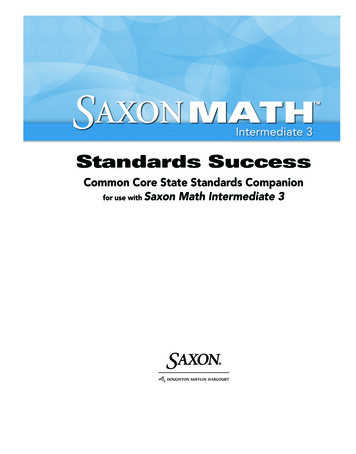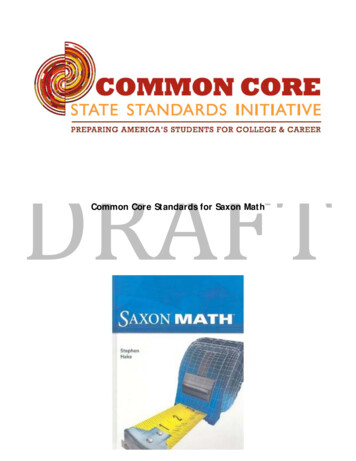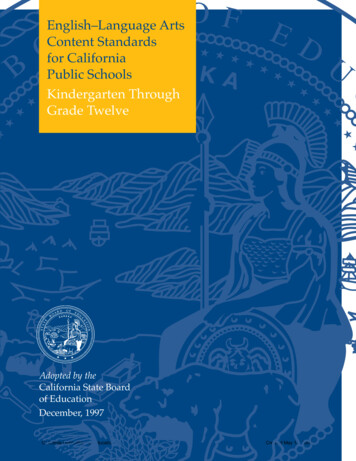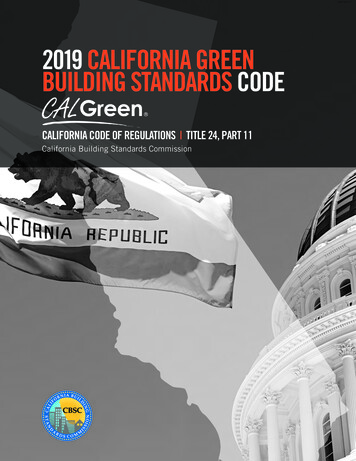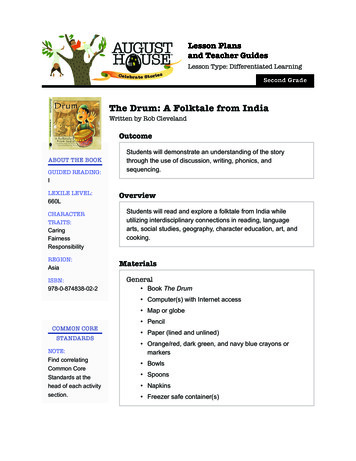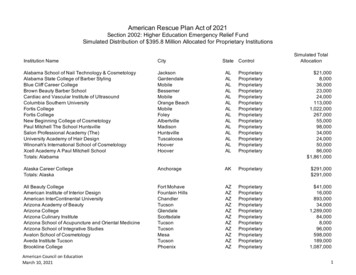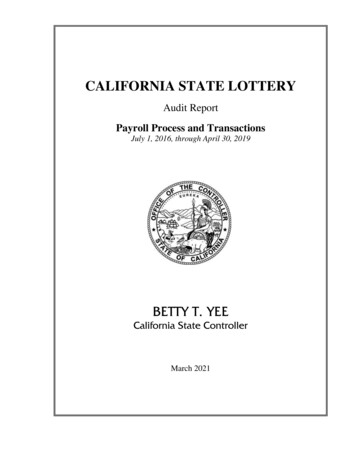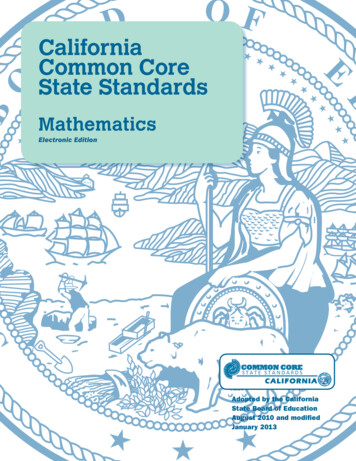
Transcription
CaliforniaCommon CoreState StandardsMathematicsElectronic EditionAdopted by the CaliforniaState Board of EducationAugust 2010 and modifiedJanuary 2013
CaliforniaCommon CoreState StandardsMathematicsElectronic EditionAdopted by the California State Board of EducationAugust 2010 and modified January 2013
Publishing InformationSenate Bill 1200, Statutes of 2012, called for modification of the California additions to the Common Core State Standardsfor Mathematics. The California Common Core State Standards: Mathematics (CA CCSSM) were modified January 16, 2013,following the recommendation of State Superintendent of Public Instruction (SSPI) Tom Torlakson. SSPI Torlakson consultedthe Mathematics Curriculum Framework and Evaluation Criteria Committee regarding modifications to the CA CCSSM and theorganization of model courses in higher mathematics. SSPI Torlakson and the State Board of Education (SBE) convened twopublic hearings in order for the field to provide input on the recommended modifications. When the CA CCSSM were modified,the members of the SBE were Michael W. Kirst, President; Trish Boyd Williams, Vice President; Sue Burr; Carl A. Cohn; BruceHoladay; Josephine Kao; Aida Molina; Patricia Ann Rucker; Nicolasa Sandoval; and Ilene Straus.Senate Bill 1 from the fifth Extraordinary Session (SB X5 1) in 2010 established the California Academic Content StandardsCommission (Commission) to evaluate the Common Core State Standards for Mathematics developed by the Common CoreState Standards Initiative for rigor and alignment with the California standards. Based on the evaluation, the Commission inserted words, phrases, and select California standards to maintain California’s high expectations for students. On July 15, 2010,the Commission recommended that the SBE adopt the CA CCSSM as amended. The members of the Commission were GregGeeting, Chair; Heather Calahan; Steven Dunlap; Robert Ellis; Eleanor Evans; Bill Evers; Scott Farrand; Mark Freathy; Lori Freiermuth; Bruce Grip; Kathy Harris; Jeanne Jelnick; Deborah Keys; James Lanich; Matt Perry; Pat Sabo; Brian Shay; Alba Sweeney;Hilda Villarreal Writ; Chuck Weis; and Ze’ev Wurman. Support for the Commission was provided by the Sacramento County Officeof Education under the direction of Sue Stickel, Deputy Superintendent of Schools.When the CA CCSSM were adopted by the SBE on August 2, 2010, the members of the SBE were Theodore Mitchell, President;Ruth Bloom, Vice President; Alan Arkatov; James Aschwanden; Benjamin Austin; Yvonne Chan; Gregory Jones; David Lopez; andJohnathan Williams. Jack O’Connell, former State Superintendent of Public Instruction, is also recognized for his leadership during the adoption of the standards in August 2010.The California Common Core State Standards: Mathematics was edited in part by the staff of CDE Press, with the cover and interior design prepared by Tuyet Truong. It was published by the California Department of Education, 1430 N Street, Sacramento,CA 95814-5901. It was distributed under the provisions of the Library Distribution Act and Government Code Section 11096.The Common Core State Standards appear as they were published by the Common Core State Standards Initiative.The electronic edition of this document is slightly different from the print publication issued by the California Department ofEducation in 2013; it includes minor text and typographical corrections. 2013, 2014 by the California Department of EducationAll rights reservedISBN 978-0-8011-1748-8Reproduction of this document for resale, in whole or in part, is not authorizedii
Special AcknowledgmentsSpecial appreciation is extended to Tom Torlakson, State Superintendent of Public Instruction, for support of the revision andupdate of the CA CCSSM. Special commendation is extended to Lupita Cortez Alcalá, Deputy Director, Instruction and LearningSupport Branch; Thomas Adams, Director, Curriculum Frameworks and Instructional Resources Division; and Kristen Cruz Allen,Administrator, and Deborah Franklin, Consultant, Curriculum Frameworks Unit.Special recognition is awarded to Joy Kessel, Analyst, Common Core Systems Implementation Office, for her contribution to theoriginal organization and format design.Ordering InformationCopies of the California Common Core State Standards: Mathematics are available for purchase from the California Departmentof Education. For prices and ordering information, please visit the Department Web site at http://www.cde.ca.gov/re/pn/rc orcall the CDE Press Sales Office at 1-800-995-4099.NoticeThe guidance in the California Common Core State Standards: Mathematics is not binding on local educational agencies orother entities. Except for the statutes, regulations, and court decisions that are referenced herein, the document is exemplary,and compliance with it is not mandatory. (See California Education Code Section 33308.5).iii
ContentsA Message from the State Board of Education and the State Superintendent of Public Instruction . vIntroduction .1Standards for Mathematical Practice .6K–8 Standards .9Kindergarten . 10Grade 1 . 14Grade 2 . 18Grade 3 . 23Grade 4 . 28Grade 5 . 34Grade 6 . 40Grade 7 . 46Grade 8 . 52Higher Mathematics Standards .57Higher Mathematics Courses . 59Traditional Pathway. 59Algebra I . 60Geometry . 69Algebra II . 77Integrated Pathway . 85Mathematics I . 86Mathematics II. 95Mathematics III. 105Advanced Mathematics . 113Advanced Placement Probability and Statistics Standards. 114Calculus Standards. 116Higher Mathematics Standards by Conceptual Category . 119Number and Quantity . 120Algebra. 123Functions . 127Modeling . 131Geometry . 133Statistics and Probability. 138Glossary.143iv
A Message from the State Board of Educationand the State Superintendent of Public InstructionThe California Common Core State Standards: Mathematics (CA CCSSM) reflect the importance of focus, coherence, and rigoras the guiding principles for mathematics instruction and learning. California’s implementation of the CA CCSSM demonstrates acommitment to providing a world-class education for all students that supports college and career readiness and the knowledgeand skills necessary to fully participate in the twenty-first-century global economy.The CA CCSSM build on California’s standards-based educational system in which curriculum, instruction, professional learning,assessment, and accountability are aligned to support student attainment of the standards. The CA CCSSM incorporate currentresearch and input from education stakeholders—including other state departments of education, scholars, professionalorganizations, teachers and other educators, parents, and students. California additions to the standards (identified in boldfacetext and followed by the abbreviation “CA”) were incorporated in an effort to retain the consistency and precision of our paststandards. The CA CCSSM are internationally benchmarked, research-based, and unequivocally rigorous.The standards call for learning mathematical content in the context of real-world situations, using mathematics to solve problems,and developing “habits of mind” that foster mastery of mathematics content as well as mathematical understanding. Thestandards for kindergarten through grade 8 prepare students for higher mathematics. The standards for higher mathematicsreflect the knowledge and skills that are necessary to prepare students for college and careers and productive citizenship.Implementation of the CA CCSSM will take time and effort, but it also provides a new and exciting opportunity to ensure thatCalifornia’s students are held to the same high expectations in mathematics as their national and global peers. AlthoughCalifornia educators have implemented standards before, the CA CCSSM require not only rigorous curriculum and instructionbut also conceptual understanding, procedural skill and fluency, and the ability to apply mathematics. In short, the standardscall for meeting the challenges of the twenty-first century through innovation.MICHAEL W. KIRST, PresidentCalifornia State Board of EducationTOM TORLAKSONState Superintendent of Public Instructionv
Page VI is blank.Do not print this instruction.
Introduction
IntroductionAll students need a high-quality mathematics program designed to prepare them to graduate from high school ready for collegeand careers. In support of this goal, California adopted the California Common Core State Standards: Mathematics (CA CCSSM)in August 2010, replacing the 1997 statewide mathematics academic standards. As part of the modification of the CA CCSSM inJanuary 2013, the California State Board of Education also approved higher mathematics standards organized into model courses.The CA CCSSM are designed to be robust, linked within and across grades, and relevant to the real world, reflecting theknowledge and skills that young people will need for success in college and careers. With California’s students fully preparedfor the future, our students will be positioned to compete successfully in the global economy.The development of the standards began as a voluntary, state-led effort coordinated by the Council of Chief State SchoolOfficers (CCSSO) and the National Governors Association (NGA) Center for Best Practices. Both organizations were committedto developing a set of standards that would help prepare students for success in career and college. The CA CCSSM are basedon evidence of the skills and knowledge needed for college and career readiness and an expectation that students be able toknow and do mathematics by solving a range of problems and engaging in key mathematical practices.The development of the standards was informed by international benchmarking and began with research on what is knownabout how students’ mathematical knowledge, skills, and understanding develop over time. The progression from kindergartenstandards to standards for higher mathematics exemplifies the three principles of focus, coherence, and rigor that are the basisof the CCSSM.The first principle, focus, means that instruction should focus deeply on only those concepts that are emphasized in thestandards so that students can gain strong foundational conceptual understanding, a high degree of procedural skill andfluency, and the ability to apply the mathematics they know to solve problems inside and outside the mathematics classroom.Coherence arises from mathematical connections. Some of the connections in the standards knit topics together at a singlegrade level. Most connections are vertical, as the standards support a progression of increasing knowledge, skill, and sophistication across the grades. Finally, rigor requires that conceptual understanding, procedural skill and fluency, and application beapproached with equal intensity.Two Types of StandardsThe CA CCSSM include two types of standards: Eight Mathematical Practice Standards (identical for each grade level) andMathematical Content Standards (different at each grade level). Together these standards address both “habits of mind” thatstudents should develop to foster mathematical understanding and expertise and skills and knowledge—what students need toknow and be able to do. The mathematical content standards were built on progressions of topics across grade levels, informedby both research on children’s cognitive development and by the logical structure of mathematics.The Standards for Mathematical Practice (MP) are the same at each grade level, with the exception of an additional practicestandard included in the CA CCSSM for higher mathematics only: MP3.1: Students build proofs by induction and proofs bycontradiction. CA This standard may be seen as an extension of Mathematical Practice 3, in which students construct viablearguments and critique the reasoning of others. Ideally, several MP standards will be evident in each lesson as they interactand overlap with each other. The MP standards are not a checklist; they are the basis of mathematics instruction and learning.Structuring the MP standards can help educators recognize opportunities for students to engage with mathematics in gradeappropriate ways. The eight MP standards may be grouped into four categories as illustrated in the following chart.2
2. Reason abstractly and quantitatively.3. Construct viable arguments andcritique the reasoning of others.4. Model with mathematics.6. Attend to precision.1. Make sense of problems and persevere insolving them.Overarching habits of mind ofa productive mathematical thinkerStructuring the Standards for Mathematical Practice15. Use appropriate tools strategically.Reasoning and explainingModeling and using tools7. Look for and make use of structure.8. Look for and express regularity in repeatedreasoning.Seeing structure and generalizingThe CA CCSSM call for mathematical practices and mathematical content to be connected as students engage in mathematicaltasks. These connections are essential to support the development of students’ broader mathematical understanding—studentswho lack understanding of a topic may rely too heavily on procedures. The MP standards must be taught as carefully andpracticed as intentionally as the Standards for Mathematical Content. Neither should be isolated from the other; effectivemathematics instruction occurs when the two halves of the CA CCSSM come together as a powerful whole.How to Read the StandardsKindergarten–Grade 8In kindergarten through grade 8, the CA CCSSM are organized by grade level and then by domains (clusters of standardsthat address “big ideas” and support connections of topics across the grades), clusters (groups of related standards insidedomains), and finally by the standards (what students should understand and be able to do). The standards do not dictatecurriculum or pedagogy. For example, just because Topic A appears before Topic B in the standards for a given grade does notmean that Topic A must be taught before Topic B.The code for each standard begins with the grade level, followed by the domain code and the number of the standard. For example,“3.NBT 2” would be the second standard in the domain of Number and Operations in Base Ten of the standards for grade 3.1. Bill McCallum. 2011. Structuring the Mathematical Practices. 03/practices.pdf(accessed April 1, 2013).3
DomainNumber and Operations in Base Ten3.NBTUse place value understanding and properties of operations to perform multi-digit arithmetic.1. Use place value understanding to round whole numbers to the nearest 10 or 100.2. Fluently add and subtract within 1000 using strategies and algorithms based on placevalue, properties of operations, and/or the relationship between addition and subtraction.StandardCluster3. Multiply one-digit whole numbers by multiples of 10 in the range 10–90 (e.g., 9 80,5 60) using strategies based on place value and properties of operations.Higher MathematicsIn California, the CA CCSSM for higher mathematics are organized into both model courses and conceptual categories. Thehigher mathematics courses adopted by the State Board of Education in January 2013 are based on the guidance provided inAppendix A published by the Common Core State Standards Initiative.2 The model courses for higher mathematics are organizedinto two pathways: traditional and integrated. The traditional pathway consists of the higher mathematics standards organizedalong more traditional lines into Algebra I, Geometry, and Algebra II courses. The integrated pathway consists of the coursesMathematics I, II, and III. The integrated pathway presents higher mathematics as a connected subject, in that each coursecontains standards from all six of the conceptual categories. In addition, two advanced higher mathematics courses wereretained from the 1997 mathematics standards: Advanced Placement Probability and Statistics and Calculus.The standards for higher mathematics are also organized into conceptual categories: Number and QuantityAlgebraFunctionsModelingGeometryStatistics and ProbabilityThe conceptual categories portray a coherent view of higher mathematics based on the realization that students’ work on abroad topic, such as functions, crosses a number of traditional course boundaries. As local school districts develop a full rangeof courses and curriculum in higher mathematics, the organization of standards by conceptual categories offers a starting pointfor discussing course content.The code for each higher mathematics standard begins with the identifier for the conceptual category code (N, A, F, G, S),followed by the domain code and the number of the standard. For example, “F-LE.5” would be the fifth standard in the domainof Linear, Quadratic, and Exponential Models in the conceptual category of Functions.2. Appendix A provides guidance to the field on developing higher mathematics courses. This appendix is available on the Common Core State StandardsInitiative Web site at http://www.corestandards.org/Math.4
FunctionsConceptualCategoryConceptual Categoryand Domain CodesLinear, Quadratic, and Exponential ModelsInterpret expressions for functions in terms of the situation they model.DomainF-LE5. Interpret the parameters in a linear or exponential function in terms of a context. ClusterHeading6. Apply quadratic functions to physical problems, such as the motion of an objectunder the force of gravity. CA California Addition:Boldface CAModelingStandardThe star symbol ( ) following the standard indicates that it is also a Modeling standard. Modeling is best interpreted not asa collection of isolated topics but in relation to other standards. Making mathematical models is an MP standard, and modelingstandards appear throughout the higher mathematics standards indicated by a symbol. Additional mathematics that studentsshould learn in order to take advanced courses such as calculus, advanced statistics, or discrete mathematics is indicated bya plus symbol ( ). Standards with a ( ) symbol may appear in courses intended for all students.5
Standards forMathematical PracticeThe Standards for Mathematical Practice describe varieties of expertise that mathematics educators at all levels should seekto develop in their students. These practices rest on important “processes and proficiencies” with longstanding importancein mathematics education. The first of these are the NCTM process standards of problem solving, reasoning and proof, communication, representation, and connections. The second are the strands of mathematical proficiency specified in the NationalResearch Council’s report Adding It Up: adaptive reasoning, strategic competence, conceptual understanding (comprehensionof mathematical concepts, operations and relations), procedural fluency (skill in carrying out procedures flexibly, accurately,efficiently and appropriately), and productive disposition (habitual inclination to see mathematics as sensible, useful, andworthwhile, coupled with a belief in diligence and one’s own efficacy).1) Make sense of problems and persevere in solving them.Mathematically proficient students start by explaining to themselves the meaning of a problem and looking for entry points to itssolution. They analyze givens, constraints, relationships, and goals. They make conjectures about the form and meaning of thesolution and plan a solution pathway rather than simply jumping into a solution attempt. They consider analogous problems, andtry special cases and simpler forms of the original problem in order to gain insight into its solution. They monitor and evaluatetheir progress and change course if necessary. Older students might, depending on the context of the problem, transform algebraic expressions or change the viewing window on their graphing calculator to get the information they need. Mathematicallyproficient students can explain correspondences between equations, verbal descriptions, tables, and graphs or draw diagramsof important features and relationships, graph data, and search for regularity or trends. Younger students might rely on usingconcrete objects or pictures to help conceptualize and solve a problem. Mathematically proficient students check their answersto problems using a different method, and they continually ask themselves, “Does this make sense?” They can understand theapproaches of others to solving complex problems and identify correspondences between different approaches.2) Reason abstractly and quantitatively.Mathematically proficient students make sense of quantities and their relationships in problem situations. They bring twocomplementary abilities to bear on problems involving quantitative relationships: the ability to decontextualize—to abstract agiven situation and represent it symbolically and manipulate the representing symbols as if they have a life of their own, withoutnecessarily attending to their referents—and the ability to contextualize, to pause as needed during the manipulation process inorder to probe into the referents for the symbols involved. Quantitative reasoning entails habits of creating a coherent representation of the problem at hand; considering the units involved; attending to the meaning of quantities, not just how to computethem; and knowing and flexibly using different properties of operations and objects.3) Construct viable arguments and critique the reasoning of others.Mathematically proficient students understand and use stated assumptions, definitions, and previously established resultsin constructing arguments. They make conjectures and build a logical progression of statements to explore the truth of theirconjectures. They are able to analyze situations by breaking them into cases, and can recognize and use counterexamples.They justify their conclusions, communicate them to others, and respond to the arguments of others. They reason inductivelyabout data, making plausible arguments that take into account the context from which the data arose. Mathematically proficientstudents are also able to compare the effectiveness of two plausible arguments, distinguish correct logic or reasoning from thatwhich is flawed, and—if there is a flaw in an argument—explain what it is. Elementary students can construct argumentsusing concrete referents such as objects, drawings, diagrams, and actions. Such arguments can make sense and be correct,even though they are not generalized or made formal until later grades. Later, students learn to determine domains to which an6 Standards for Mathematical Practice
argument applies. Students at all grades can listen to or read the arguments of others, decide whether they make sense, andask useful questions to clarify or improve the arguments. Students build proofs by induction and proofs by contradiction.CA 3.1 (for higher mathematics only).4) Model with mathematics.Mathematically proficient students can apply the mathematics they know to solve problems arising in everyday life, society,and the workplace. In early grades, this might be as simple as writing an addition equation to describe a situation. In middlegrades, a student might apply proportional reasoning to plan a school event or analyze a problem in the community. By highschool, a student might use geometry to solve a design problem or use a function to describe how one quantity of interestdepends on another. Mathematically proficient students who can apply what they know are comfortable making assumptionsand approximations to simplify a complicated situation, realizing that these may need revision later. They are able to identifyimportant quantities in a practical situation and map their relationships using such tools as diagrams, two-way tables, graphs,flowcharts and formulas. They can analyze those relationships mathematically to draw conclusions. They routinely interpret theirmathematical results in the context of the situation and reflect on whether the results make sense, possibly improving the modelif it has not served its purpose.5) Use appropriate tools strategically.Mathematically proficient students consider the available tools when solving a mathematical problem. These tools might includepencil and paper, concrete models, a ruler, a protractor, a calculator, a spreadsheet, a computer algebra system, a statisticalpackage, or dynamic geometry software. Proficient students are sufficiently familiar with tools appropriate for their grade orcourse to make sound decisions about when each of these tools might be helpful, recognizing both the insight to be gained andtheir limitations. For example, mathematically proficient high school students analyze graphs of functions and solutions generatedusing a graphing calculator. They detect possible errors by strategically using estimation and other mathematical knowledge.When making mathematical models, they know that technology can enable them to visualize the results of varying assumptions,explore consequences, and compare predictions with data. Mathematically proficient students at various grade levels are ableto identify relevant external mathematical resources, such as digital content located on a website, and use them to pose orsolve problems. They are able to
Senate Bill 1200, Statutes of 2012, called for modification of the California additions to the Common Core State Standards for Mathematics. The California Common Core State Standards
